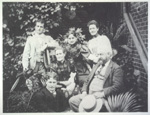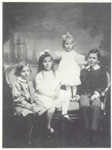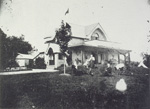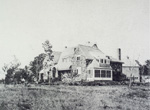THE LIVES OF
EDWARD AND WILLIAM S. MAXWELL
Henry B. Yates
The family of my grandfather Edward and my great uncle William Maxwell has Scottish origins. "The ancient and honourable house of Maxwell, so conspicuously connected with the history of Scotland, and considered one of the most distinguished... is generally believed to have been founded by Maccus, son of Undwyn, in the twelfth century." 1 In 1824, a Presbyterian marriage took place in Jedburgh, Scotland, between Edward Maxwell (1805-1876) Agnes Reid. Edward, a joiner and carpenter, emigrated to Montreal with his wife in 1829 .2 They lived on Saint-Gabriel Street near the waterfront. Several children were born to the couple, and one of them, Edward John, became a builder. In 1862 this son founded E.J. Maxwell & Co., lumber dealers specializing in hardwood and black walnut. "The yard was located on Craig Street (today's St. Antoine St.), a little to the east of Victoria Square and Beaver Hall Hill".3 This business prospered for three generations, remaining in the family until it was sold in the early 1970s.
After his marriage to Johan MacBean, Edward John lived in a large house with a garden on Côte-Saint-Antoine Road, which at that time was in the country. Two daughters were born and then two sons, Edward (1867-1923) and William (1874-1952) (cat. 2c). The sons were exposed to the basics of building and fine lumber; their father even made violins. Clearly this home environment influenced the decision of both young men to become architects.
Edward and William studied at the High School of Montreal, played sports and enjoyed a happy home. Their parents emphasized the importance of family life, diligent work and integrity. After returning from his employment in Boston in 1891, Edward lived with his parents on Côte-Saint-Antoine Road until his marriage five years later. According to family lore, when he was recovering from an illness, he spied an attractive young lady through a crack in his bedroom door. She was his third Cousin Elizabeth Ellen Aitchison, of Scottish origin, from Madrid, New York. In 1896 they were married. Edward then built a small house attached to that of his parents; several years later a house he designed on Peel Street became their home. Edward and Elizabeth had four children between 1900 and 1908: Blythe, Jean, Stirling and Elizabeth (cat. 2e).
Just before William was to write his final-year exams at the High School of Montreal, he became ill and decided not to write them, Following this, William chose to join an architectural firm in Boston. There his talent for drawing was recognized, and he was assigned detailed architectural drawings, especially cornices. His daughter, Mary Maxwell Rabbani, has remarked: "I am sure that he must have bettered the design because he had such a marvellous sense of proportion."4 At the turn of the century William studied along with American and British students at the Atelier Pascal in Paris. Mary Rabbani recalled two humorous episodes that occurred there. New students were subjected to hazing, which sometimes resulted in being stripped and entirely covered with watercolour paint. William was not spared. The second was a prank involving William and a few other students who lived in a house where the Parisian landlady owned a baby tortoise. Every week or so the students would acquire a larger tortoise and replace the incumbent. The landlady was amazed at the rapid growth and enthusiastically reported it to all her friends.
While in Paris William met Randolph Bolles, an American architectural student also studying at the Atelier Pascal. William and Randolph became devoted friends, and in 1902 William married Randolph's sister May in London.5 That same year William became a partner in the architectural firm of Edward & W. S. Maxwell in Montreal. The brothers' varied talents combined to make an excellent team. Edward was not only a fine architect but also had a keen business sense. He developed contacts with and entertained the many influential people he knew in business and government. William, on the other hand, had a remarkable ability for fine drawing and design. According to his daughter Mary, he was "fundamentally ... a scholar and a creator and very much of a recluse. He wasn't interested in social life, but he had a passion for everything to do with art and architecture. He had a knowledge that was literally encyclopedic."
In 1899 Edward was summoned to Saint Andrews, New Brunswick, by Sir William Van Horne, president of the Canadian Pacific Railway, to help with the building of his summer house on Minister's Island. At Sir William's suggestion, Edward purchased a choice piece of land nearby, on the sea, and built a modest summer house, "Tillietudlem" (fig. 1), the name perhaps inspired by Tillietudlem Castle in the Walter Scott novel Old Mortality.
In 1908 Edward bought one hundred and sixty acres (65 ha) of farmland in Baie-d'Urfé on Montreal Island. Here he built "Maxwelton", a large fieldstone house (fig. 2), and developed a choice herd of Jersey cattle.
Edward and William knew many leading artists in Montreal, and studio space above their office on Beaver Hall Hill was occupied by artists such as the three Des Clayes sisters, Laura Muntz and G. Horne Russell.6 An important employee in the office for many decades was Amelia M. Parent, who performed many duties as administrative assistant. Although she was a frail lady, her great ability and sense of loyalty "kept the firm together".7 William's daughter recalls that the Maxwell firm was the largest and most prominent in Canada before World War 1, and she believes that at its height it employed as many as fifty-six draftsmen. However after the war, with the death of Edward in 1923, the firm never regained its former prominence.
Both Edward and William were elected to the Royal Canadian Academy of Arts. William also served as president of the Arts Club in Montreal and belonged to the Pen and Pencil Club of Montreal.8 Every Friday he would go to the Arts Club with his friends, mostly architects and artists, and spend "the whole evening in a big cloud of blue smoke. There he talked of the subjects that interested him, played poker and billiards."9 Many leading figures in the art and academic world frequented these clubs, including artists William Brymner, Maurice Cullen, Clarence A. Gagnon, Robert Harris and Robert W. Pilot, and humourist Stephen Leacock.10
Over the years William avidly collected books on art and architecture as well as antiques. On one occasion, soon after his marriage, he was taking a streetcar home from work and spotted an auction of carpets. He leapt off the trolley, spent the $ 100 and more he and his wife had for the next month's living expenses, and happily arrived home with a roll of carpets under each arm.11
Edward developed cancer and died in 1923, whereupon William formed a partnership with Gordon Pitts of Montreal. In 1940 William's wife died, and the next year he moved to Haifa, Israel, to live with his daughter Mary, who had married Shoghi Fffendi Rabbani, head of the World Baha'í Faith. It was here that William designed his most unique building, the Shrine of the B´b, located in extensive gardens on the slopes of Mount Carmel. In poor health, William returned to Canada in 1952 and soon died in the city of his birth.
1 Florence Wilson Houston, Laura Cowan Blaine and Ella Dunn Mellette, Maxwell History and Genealogy (Indianapolis: C.E. Pauley, 1916), p. 1. Resume Text
2 Maxwell family papers, private collection, Montreal. Resume Text
3 "Montreal Then and Now", The Gazette (Montreal), October 24, 1987, p. K- 11 Resume Text
4 Mary Maxwell Rabbani, interview by France Gagnon Pratte and Rosalind M . Pepall, Haifa, April 1, 1989. Resume Text
5 Randolph Bolles worked for Edward & W.S. Maxwell from 1912 to 1926 and then retired to Washington, Connecticut, a small town near New Haven (Jan Bolles Chute [daughter of Randolph], interview by the author, Haifa, March 28, 1989). Resume Text
6 Mary Maxwell Rabbani files, Haifa. Resume Text
7 Rabbani interview, April 1, 1989. Resume Text
8 Canadian Newspaper Service, National Reference Book on Canadian Men and Women, 5th edition (Montreal: H. Harrison, 1936), pp. 510-511. Resume Text
9 Rabbani interview, April 1, 1989. Resume Text
10 Leo Cox, "Fifty Years of Brush and Pen: A Historical Sketch of the Pen and Pencil Club of Montreal" (unpublished manuscript, 1939), pp. 8-10. Resume Text
11 Rabbani interview, April 1, 1989. Resume Text
Henry B. Yates
The family of my grandfather Edward and my great uncle William Maxwell has Scottish origins. "The ancient and honourable house of Maxwell, so conspicuously connected with the history of Scotland, and considered one of the most distinguished... is generally believed to have been founded by Maccus, son of Undwyn, in the twelfth century." 1 In 1824, a Presbyterian marriage took place in Jedburgh, Scotland, between Edward Maxwell (1805-1876) Agnes Reid. Edward, a joiner and carpenter, emigrated to Montreal with his wife in 1829 .2 They lived on Saint-Gabriel Street near the waterfront. Several children were born to the couple, and one of them, Edward John, became a builder. In 1862 this son founded E.J. Maxwell & Co., lumber dealers specializing in hardwood and black walnut. "The yard was located on Craig Street (today's St. Antoine St.), a little to the east of Victoria Square and Beaver Hall Hill".3 This business prospered for three generations, remaining in the family until it was sold in the early 1970s.
After his marriage to Johan MacBean, Edward John lived in a large house with a garden on Côte-Saint-Antoine Road, which at that time was in the country. Two daughters were born and then two sons, Edward (1867-1923) and William (1874-1952) (cat. 2c). The sons were exposed to the basics of building and fine lumber; their father even made violins. Clearly this home environment influenced the decision of both young men to become architects.
Edward and William studied at the High School of Montreal, played sports and enjoyed a happy home. Their parents emphasized the importance of family life, diligent work and integrity. After returning from his employment in Boston in 1891, Edward lived with his parents on Côte-Saint-Antoine Road until his marriage five years later. According to family lore, when he was recovering from an illness, he spied an attractive young lady through a crack in his bedroom door. She was his third Cousin Elizabeth Ellen Aitchison, of Scottish origin, from Madrid, New York. In 1896 they were married. Edward then built a small house attached to that of his parents; several years later a house he designed on Peel Street became their home. Edward and Elizabeth had four children between 1900 and 1908: Blythe, Jean, Stirling and Elizabeth (cat. 2e).
Just before William was to write his final-year exams at the High School of Montreal, he became ill and decided not to write them, Following this, William chose to join an architectural firm in Boston. There his talent for drawing was recognized, and he was assigned detailed architectural drawings, especially cornices. His daughter, Mary Maxwell Rabbani, has remarked: "I am sure that he must have bettered the design because he had such a marvellous sense of proportion."4 At the turn of the century William studied along with American and British students at the Atelier Pascal in Paris. Mary Rabbani recalled two humorous episodes that occurred there. New students were subjected to hazing, which sometimes resulted in being stripped and entirely covered with watercolour paint. William was not spared. The second was a prank involving William and a few other students who lived in a house where the Parisian landlady owned a baby tortoise. Every week or so the students would acquire a larger tortoise and replace the incumbent. The landlady was amazed at the rapid growth and enthusiastically reported it to all her friends.
While in Paris William met Randolph Bolles, an American architectural student also studying at the Atelier Pascal. William and Randolph became devoted friends, and in 1902 William married Randolph's sister May in London.5 That same year William became a partner in the architectural firm of Edward & W. S. Maxwell in Montreal. The brothers' varied talents combined to make an excellent team. Edward was not only a fine architect but also had a keen business sense. He developed contacts with and entertained the many influential people he knew in business and government. William, on the other hand, had a remarkable ability for fine drawing and design. According to his daughter Mary, he was "fundamentally ... a scholar and a creator and very much of a recluse. He wasn't interested in social life, but he had a passion for everything to do with art and architecture. He had a knowledge that was literally encyclopedic."
In 1899 Edward was summoned to Saint Andrews, New Brunswick, by Sir William Van Horne, president of the Canadian Pacific Railway, to help with the building of his summer house on Minister's Island. At Sir William's suggestion, Edward purchased a choice piece of land nearby, on the sea, and built a modest summer house, "Tillietudlem" (fig. 1), the name perhaps inspired by Tillietudlem Castle in the Walter Scott novel Old Mortality.
In 1908 Edward bought one hundred and sixty acres (65 ha) of farmland in Baie-d'Urfé on Montreal Island. Here he built "Maxwelton", a large fieldstone house (fig. 2), and developed a choice herd of Jersey cattle.
Edward and William knew many leading artists in Montreal, and studio space above their office on Beaver Hall Hill was occupied by artists such as the three Des Clayes sisters, Laura Muntz and G. Horne Russell.6 An important employee in the office for many decades was Amelia M. Parent, who performed many duties as administrative assistant. Although she was a frail lady, her great ability and sense of loyalty "kept the firm together".7 William's daughter recalls that the Maxwell firm was the largest and most prominent in Canada before World War 1, and she believes that at its height it employed as many as fifty-six draftsmen. However after the war, with the death of Edward in 1923, the firm never regained its former prominence.
Both Edward and William were elected to the Royal Canadian Academy of Arts. William also served as president of the Arts Club in Montreal and belonged to the Pen and Pencil Club of Montreal.8 Every Friday he would go to the Arts Club with his friends, mostly architects and artists, and spend "the whole evening in a big cloud of blue smoke. There he talked of the subjects that interested him, played poker and billiards."9 Many leading figures in the art and academic world frequented these clubs, including artists William Brymner, Maurice Cullen, Clarence A. Gagnon, Robert Harris and Robert W. Pilot, and humourist Stephen Leacock.10
Over the years William avidly collected books on art and architecture as well as antiques. On one occasion, soon after his marriage, he was taking a streetcar home from work and spotted an auction of carpets. He leapt off the trolley, spent the $ 100 and more he and his wife had for the next month's living expenses, and happily arrived home with a roll of carpets under each arm.11
Edward developed cancer and died in 1923, whereupon William formed a partnership with Gordon Pitts of Montreal. In 1940 William's wife died, and the next year he moved to Haifa, Israel, to live with his daughter Mary, who had married Shoghi Fffendi Rabbani, head of the World Baha'í Faith. It was here that William designed his most unique building, the Shrine of the B´b, located in extensive gardens on the slopes of Mount Carmel. In poor health, William returned to Canada in 1952 and soon died in the city of his birth.
1 Florence Wilson Houston, Laura Cowan Blaine and Ella Dunn Mellette, Maxwell History and Genealogy (Indianapolis: C.E. Pauley, 1916), p. 1. Resume Text
2 Maxwell family papers, private collection, Montreal. Resume Text
3 "Montreal Then and Now", The Gazette (Montreal), October 24, 1987, p. K- 11 Resume Text
4 Mary Maxwell Rabbani, interview by France Gagnon Pratte and Rosalind M . Pepall, Haifa, April 1, 1989. Resume Text
5 Randolph Bolles worked for Edward & W.S. Maxwell from 1912 to 1926 and then retired to Washington, Connecticut, a small town near New Haven (Jan Bolles Chute [daughter of Randolph], interview by the author, Haifa, March 28, 1989). Resume Text
6 Mary Maxwell Rabbani files, Haifa. Resume Text
7 Rabbani interview, April 1, 1989. Resume Text
8 Canadian Newspaper Service, National Reference Book on Canadian Men and Women, 5th edition (Montreal: H. Harrison, 1936), pp. 510-511. Resume Text
9 Rabbani interview, April 1, 1989. Resume Text
10 Leo Cox, "Fifty Years of Brush and Pen: A Historical Sketch of the Pen and Pencil Club of Montreal" (unpublished manuscript, 1939), pp. 8-10. Resume Text
11 Rabbani interview, April 1, 1989. Resume Text

Cat. 2c. Edward John Maxwell family: Edward, William, Johan MacBean Maxwell (mother)Amelia, Jessie Gertrude and Edward John(father)

Cat. 2e.Edward Maxwell's children: Stirling, Jean, Elizabeth and Blythe

Photographer unknown,Edward Maxwell House ("Tillietudlem"), Saint Andrews, N.B. (Edward Maxwell, architect), about 1908. Private collection

William Notman & Son, Edward Maxwell House ("Maxwelton"), Baie-d'Urfe, Que. (Edward Maxwell, architect), about 1921. Private collection.